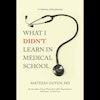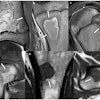
U.K. researchers have found that increased blinking -- often a key indicator of visual fatigue -- occurs after examining 20 digital breast tomosynthesis (DBT) cases. Taking a break after 20 reports may help to eliminate mistakes, they suggest.
"Due to its long reporting times, DBT can be subjected to fatigue and errors in reporting," noted Dr. Dorina Roy, research associate in the Division of Cancer and Stem Cells, University of Nottingham, and colleagues. "These findings indicate that after reading 20 DBT cases, individuals were beginning to show signs of visual fatigue onset, and so we would recommend that radiologists take a break after this number of cases are read."
DBT has a higher sensitivity and specificity compared with full-field digital mammography or standard 2D digital mammography for reporting abnormal breast lesions, they reported at RCR Digital 2020, the Royal College of Radiologists' (RCR) online learning program. However, problems with its incorporation into the national screening programs for breast cancer are mainly related to the DBT being a new modality of assessment as well as the long reporting time per case, the authors explained.
Fatigue measurement
The Nottingham group aimed to objectively identify and analyze significant parameters obtained through the eye tracking of radiologists and radiographers in different facilities. The investigators observed and recorded the development and progression of fatigue and resultant increased vigilance while reading screening DBT cases for breast cancer pathology.
In the study, 13 participants from three U.K. NHS breast screening units read a set of 40 DBT cases (16 normal, 19 malignant, and five benign). They read the entire set in one session and verbally reported them, and at the same time the researchers recorded the visual search behavior using a nonintrusive remote eye-tracking system. They noted the participants' years of experience in DBT reading, daily caseload, and level of expertise. Most readers were consultant radiologists and radiographers, and the analysis was conducted in their usual reporting ambience, according to Roy and colleagues.
The typical setup, such as the SecurView DX workstation from Hologic, consisted of a mammography reading station with a three-camera eye-tracking system and capable of performing web application. Around 120,000 data points were obtained per video recording, and blinks were identified from different eye metrics such as eyelid opening (0 mm to 2.5 mm) and pupil diameter (0 mm to 2.5 mm).
The authors found a notable difference in the average blink durations for the 20 cases (mean, 143.5 msec) and the 40 cases (mean, 228 msec). They reported that p = 0.0013.
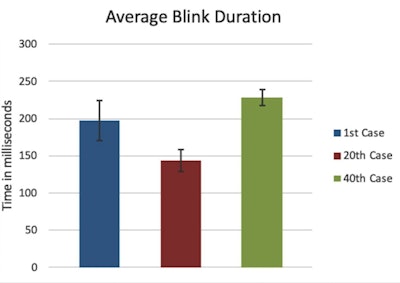 Average blink duration increased significantly between the 20th and 40th cases. All images courtesy of Dr. Dorina Roy.
Average blink duration increased significantly between the 20th and 40th cases. All images courtesy of Dr. Dorina Roy.Average eye fixation duration was also found to be significant on a paired sample t-test between the first (mean, 587 ± 69.2 msec) and 20th cases (mean, 622 ± 66.7 msec), when p = 0.02.
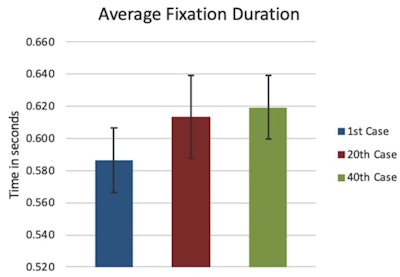 Average fixation duration rose between the first, 20th, and 40th cases.
Average fixation duration rose between the first, 20th, and 40th cases.The authors also assessed eyelid opening and pupil diameters, but they obtained no significant values due to differences in left and right eye values, which were corrected for with the help of a rolling average.
Finally, they looked at eyelid opening and eye aperture values, analyzing each participant's left and right eyes, and found that readers tend to have lesser eyelid opening apertures (< 10 mm), i.e., fatigued states or decreased vigilance after having read for more than 1.5 hours.
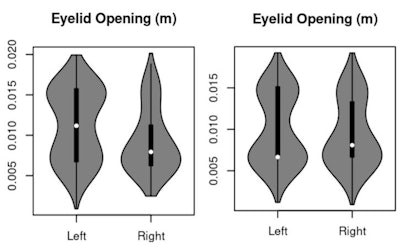 First figure: Example of a violin plot showing that the reader has more data points with larger eyelid apertures (mean greater than 12 mm) in the first two hours of reading than in the last two hours. Second figure: Violin plot of a participant's third hour, showing more data points with less than 10 mm of eye aperture. After 1.5 hours of reading, participants had more data points with smaller eye apertures.
First figure: Example of a violin plot showing that the reader has more data points with larger eyelid apertures (mean greater than 12 mm) in the first two hours of reading than in the last two hours. Second figure: Violin plot of a participant's third hour, showing more data points with less than 10 mm of eye aperture. After 1.5 hours of reading, participants had more data points with smaller eye apertures.The study was conducted by Yan Chen, PhD, associate professor of cancer screening at the University of Nottingham, who is leading the group as part of the Hologic-funded U.K. national Prospective Randomised Trial of Digital Breast Tomosynthesis.
"Reading technique appears to affect both total reading time spent and thereby visual fatigue as both a cause and effect. There appears to be an inverse relationship between time spent reading and correct reporting outcome," they wrote.
Follow-up research will include temporal analysis for every 20 minutes of reading time, which can help to identify the exact point of fatigue onset in DBT readers.
